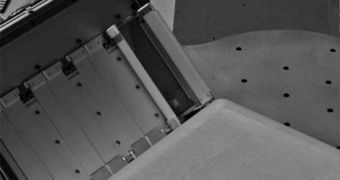After nearly a week of scraping soil and icy material off the surface of the Red Planet, NASA's Phoenix Mars Lander collected a sample and attempted to deliver it to the TEGA instrument. However, little soil of the total of 3 cubic centimeters of material it had gathered made it to the analyzer, images showing that most of the sample remained lodged inside the robotic arm's scoop.
"Very little of the icy sample made it into the oven. We believe that the material that was intended for the targeted cell is the material that adhered to the back of the scoop. The good news here is TEGA is functioning nominally, and we will adjust our sample drop-off strategy to run this again," said the Phoenix project manager Barry Goldstein of NASA's Jet Propulsion Laboratory in Pasadena.
Immediately after the soil sample was collected, NASA engineers commanded the lander to bring the scoop of the robotic arm over the opening of the oven. The scoop was then tilted and the rasp motor was started several times, in the hope that the material would be sprinkled on the screen of the opening, measuring about 10 by 3 centimeters. The heated element of the Thermal and Evolved-Gas Analyzer is in fact no larger than the ink cartridge of a typical pen.
During the last week, the lander tested several rasping and scrapping techniques, making about 16 holes into the icy surface of the planet in order to collect samples. Yesterday, the spacecraft was commanded to take images of the surrounding areas, especially those in the vicinity of the TEGA instrument to see whether or not collected samples fell on the ground instead of going into the analyzer's oven.
The Phoenix Mars Lander mission touched down on the surface of the Red Planet on May 25th, and has the role of examining the water icy layers in the northern region of the planet in order to establish if Mars was ever habitable for life as we know it. The mission should end by August 25th, although it will most likely be extended, since after two months of continuous work, the lander hasn't yet made a conclusive analysis.

 14 DAY TRIAL //
14 DAY TRIAL //